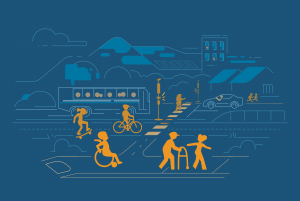Riding Through Change:
LA’s Post-COVID Transit Trends
How LA Metro increased productivity and efficiency during a decline in ridership
In the aftermath of the COVID-19 pandemic, public transit systems worldwide face unprecedented challenges with reduced ridership and changing commuter behavior. While many cities struggle with slow recovery of ridership, Los Angeles has had positive trends, showing increased year-on-year service users and overall increased usage starting to approach pre-pandemic numbers.
Amidst the post-pandemic national trend of lower transit ridership, Los Angeles stands out for its surprising improvement. Several factors have contributed to this. Firstly, investments in infrastructure and technology have enhanced service reliability and efficiency, translating into smoother operations and reduced delays. Streamlined routes and optimized schedules have also improved resource allocation, helping to maximize the system’s capacity through the period of lower passenger volumes experienced during the pandemic (mainly a result of the NextGen Bus Plan implemented a few years ago).

Initiatives promoting sustainability and equity have resonated with commuters, fostering trust and loyalty towards public transit. These initiatives include fare subsidies for young and low-income riders, and the expansion of bike lanes, bolstering overall system connectivity and accessibility, attracting a range of riders including those who prioritize environmental consciousness and social responsibility. Additionally, in 2022, the highly successful Metro Ambassador program was introduced by LA Metro. The Ambassadors are an added workforce focused on customer information and assistance at Metro Rail stations, helping to make journeys as easy and comfortable as possible for transit riders. As well as providing local transit information they connect passengers to transit resources and report on safety, cleanliness or station maintenance issues. This improves the customer experience, which is another targeted area of improvement for LA Metro during the past few years.
Multiple studies and analyses support the consistently observed reduced transit ridership trends in the post-COVID landscape. More challenging has been gaining back riders. Recent reports from Metro share statistics from initiatives that have helped improve regional transit usage. Several of these are part of the measures identified by the National Association of City Transportation Organizations (NACTO) in the midst of the pandemic a few years ago, intended to reignite interest and increased ridership on particularly bus transit services.
The post-COVID landscape of public transit ridership is characterized by nuanced dynamics, with cities like Los Angeles exemplifying the potential for regaining riders through a range of initiatives and service improvements. By leveraging technological advancements, improving community engagement, and adapting to shifting commuter behaviors, cities can chart a course towards a more resilient and inclusive public transit future.

Want to work with us? Feeling inspired?
Contact us at info@dcrdesign.net or checkout our social medias: LinkedIn, X and Instagram
For more information visit:
Vision Zero and safe systems approach. NHTSA, FHWA




